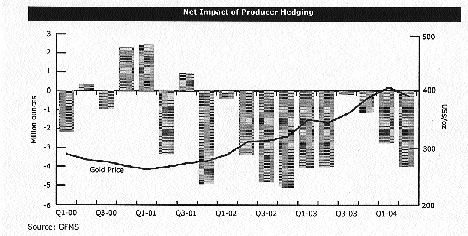Vancouver — Approximately 3.9 million oz. were trimmed from gold producers’ hedge books in the 3-month period ended June 30, marking the fourth consecutive quarter in which the global hedge book moved away from hedging.
The de-hedging trend looks likely to continue, according to Gold Fields Mineral Services, the independent, London-based commodity research and consulting company.
GFMS recently published the sixth in its quarterly series of studies tracking hedging activities.
The delta-adjusted hedge book reflects the physical market impact of 93 gold mining companies’ hedging activities. GFMS found that restructuring of existing hedge books resulted in a change in the composition of the global hedge book.
Hedging refers to selling gold forward in time by producers. The practice was especially fashionable in the late 1990s and at the beginning of the present decade, when gold prices were at record lows and companies were anxious to lock in at set prices because they did not see much upside potential for prices. Producer hedging has added about two years of future production to normal mine supply since 1996, and many believe the practice has contributed to a major suppression in the price of gold.
Forecasts from industry experts pointing to higher future gold prices are fuelling the trend to de-hedge, which has been especially evident over the past year. The price of gold reached a 15-year high of US$427.25 per oz. in April but was dampened by lower investment demand and fell by more than US$50 per oz. over the second quarter before recovering to end the period at around US$395. All in all, the gold price was 13% higher in the second quarter than in the corresponding period of 2003.
Unhedged producers benefited in that they realized an average of US$394 per oz., whereas hedged producers received US$385 per oz. on average. Realized gold prices over the quarter ranged from US$322 to US$447 per oz. and averaged US$387 per oz. Just over 60% of mine production was delivered at lower than spot prices.
GFMS reports an 11% decrease in global gold hedging between the second quarters of 2003 and 2004, which amounts to 3.9 million oz. That leaves total outstanding producer hedge positions at 64.2 million oz. gold, or 77% of gold production, compared with 68.2 million in the first quarter of 2004. In the first quarter of 2003, about 75.4 million oz., or 91% of annual mine production, were hedged.
In the June quarter, South African heavyweight
Barrick, which reduced by 0.85 million oz. in the quarter, has 13.9 million oz. outstanding. The company instituted a no-hedge gold policy in 2003, which was a significant departure from its past practice. While hedging helped Barrick sustain predictable revenue flows for most of its history, the major said it no longer needed to continue and that it was committed to bringing its book down to zero over time. In 2003, Barrick reduced its hedge position by 2.6 million oz., to 15.5 million oz., or 18% of reserves.
The period also say significant buybacks from
Embattled
Significantly, producers appear to be simplifying their hedge positions. Simple forward sales rose to 69% in the recent quarter, from 59% from the end of 2002. Barrick restructured its book by converting its calls into forward contracts in 2003, whereas
Forward sales were cut by 0.9 million oz., whereas “vanilla options” (simple put and call options) were cut by 3.9 million oz., and non-vanilla products (complex options), by 2.9 million oz. in nominal terms.
Newcrest’s 2.9-million addition to the global forward book offset the ongoing de-hedging by companies such as Barrick, AngloGold Ashanti and Harmony considerably.
The de-hedging trend began in 2002 but gathered momentum in 2003 and is continuing. The stage is set for another 7 million oz. to come off the books over the rest of 2004, which would bring the total to 13.7 million oz. for the year.
In a recent study, the World Gold Council found that consumer demand for gold continued to rise in the second quarter. For the current year, up to June 30, consumer demand is 12% higher than in the year-earlier period. In the recent second quarter, demand for jewelry and retail investment was 11% higher, in tonnage terms, than in the corresponding quarter of 2003, and 25% higher in dollar terms.
Despite a 13% rise in the price of gold, demand for gold jewelry was 8% higher, at 664 tonnes, than a year earlier, and net retail investment rose by a third, to 79 tonnes — its highest level since the late 1990s, when Y2K fears were rampant. For the eighth consecutive quarter, industrial demand continued to increase; the 7% rise is attributed to higher demand for gold in the electronics industry.
Net selling by central banks in the second quarter was only half what it was in the 2003 quarter (Argentina actually stocked up by buying 42 tonnes of the metal in the first six months of this year).
On the downside, institutional investment demand fell as some short-term holders got the jitters when gold prices failed to continue their climb.


Be the first to comment on "Global hedge books trimmed for fourth consecutive Q"